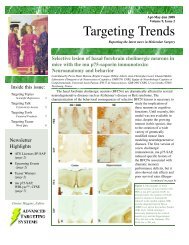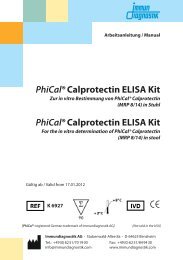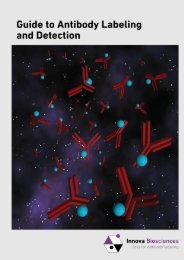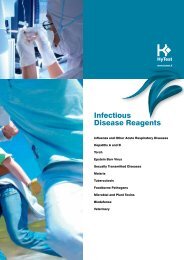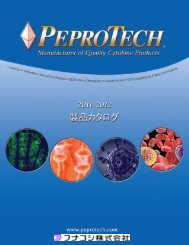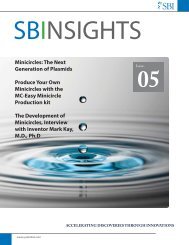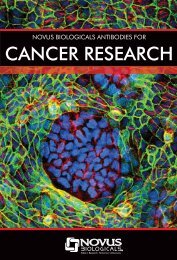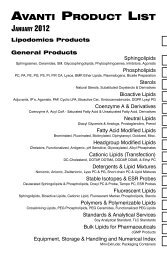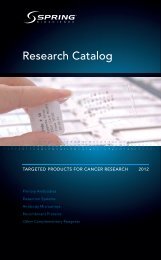Oncology Probes
Oncology Probes
Oncology Probes
- No tags were found...
You also want an ePaper? Increase the reach of your titles
YUMPU automatically turns print PDFs into web optimized ePapers that Google loves.
Chronic Myeloproliferative Disorders (CMPD)Chromosomal translocations in chronic myeloproliferativediseases (CMPD) almost invariably result inexpression of constitutively activated fusion tyrosinekinases. The hallmark of these diseases is CML, wherethe BCR/ABL activated tyrosine kinase results fromthe balanced reciprocal Philadelphia chromosometranslocation t(9;22).Chronic Myelogenous Leukemia (CML) - BCR/ABL t(9;22)CML is a malignant chronic myeloproliferative disorder (MPD)of the hematopoietic stem cell. All CML have a t(9;22) causingfusion of the 3’ ABL region at 9q34 with the 5’ BCR region at22q11. This chimeric BCR/ABL gene encodes a constitutivelyactivated protein tyrosine kinase with profound effects on cellcycle, adhesion, and apoptosis. Understanding this process hasled to the development of the drug imatinib mesylate (Gleevec),the first in a new class of genetically targeted agents, this is amajor advance in cancer treatment. Several different approachesare used to analyze the BCR/ABL t(9;22)(q34;q11) by FISH eachproviding different details about this translocation.BCR/ABL Product FamilyThe Philadelphia chromosome is an abnormally shortchromosome 22 that is one of the two chromosomes involvedin a translocation with chromosome 9. This translocation t(9;22)(q34;q11) takes place in a single bone marrow cell and, throughthe process of clonal expansion, gives rise to the leukemia.ABL and BCR are normal genes on chromosomes 9 and 22,respectively. The ABL gene encodes a tyrosine kinase enzymewhose activity is tightly controlled. In the formation of thePh translocation, two fusion genes are generated: BCR-ABLon the Ph chromosome and ABL-BCR on the chromosome 9participating in the translocation. The BCR-ABL gene encodesa protein with deregulated tyrosine kinase activity.The presence of this protein in the CML cells is strongevidence of its pathogenetic role. The efficacy in CMLof a drug that inhibits the BCRABL tyrosine kinase hasprovided the final proof that the BCR-ABL oncoprotein isthe unique cause of CML. The Poseidon portfolio containsnow 4 different probes for BCR/ABL to suit all needs forthe detection of t(9;22) by FISH:BCR/ABL t(9;22) Dual-color, Dual-Fusion ProbeD22S940SHGC-147754ASS340 KBIGLC1340 KBABLBCRInterpretationguidelines forPoseidonBCR/ABL <strong>Probes</strong>Normal Cell t(9;22) positive Cryptic insertion 9q34 to 22q11BCR/ABL t(9;22) Triple-color, Dual-Fusion Probe99q34NUP214D9S19911000 KB2222q11IGLL1SHGC-1074501000 KB<strong>Oncology</strong> <strong>Probes</strong> - Hematology <strong>Probes</strong>Normal Cellt(9;22) positiveWith del(22q11)Normal Cellt(9;22) positivet(9;22) positiveWith del(9q34)BCR/ABL t(9;22) Dual-color, Single-Fusion Extra Signal Probet(9;22) positiveBCR/ABL t(9;22) Dual-color, Single-Fusion Probe99SHGC-147754ASSABLNUP2149q34 D9S1991SHGC-147754ASSABLNUP2149q34 D9S1991SHGC-147754ASSABLNUP2149q34 D9S1991340 KB1000 KB340 KB1000 KB340 KB1000 KB2222D22S940IGLC1BCRIGLL122q11SHGC-107450D22S940IGLC1BCRIGLL122q11SHGC-107450D22S940IGLC1BCRIGLL122q11340 KB1000 KB340 KB340 KB92212Normal Cellt(9;22) positive



